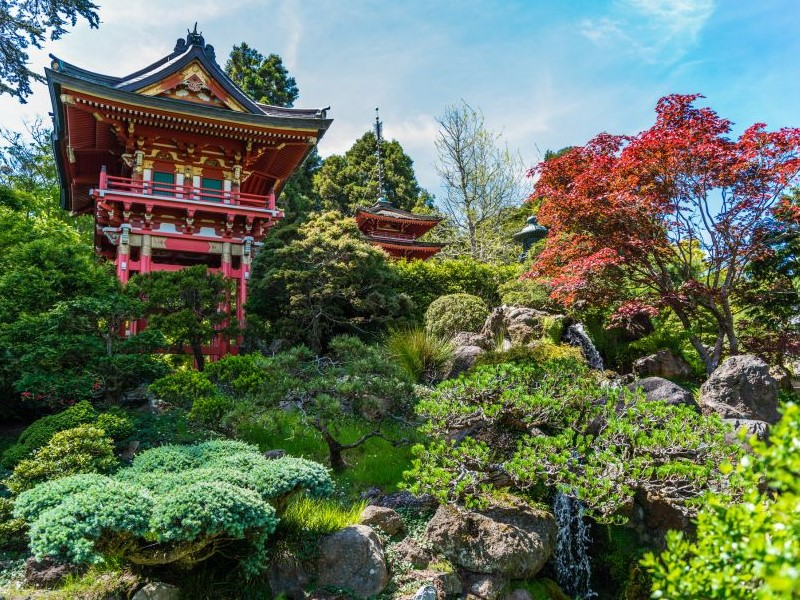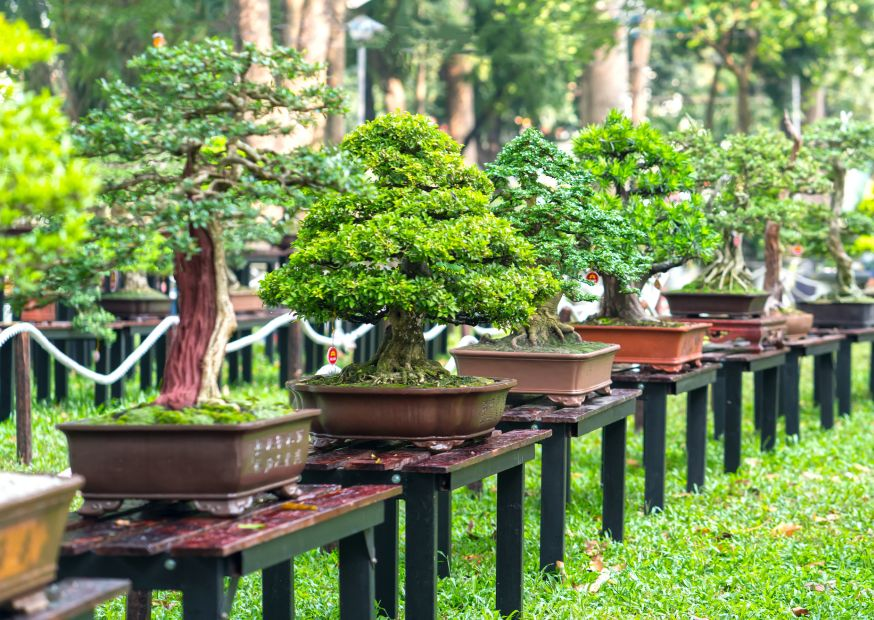Have you ever wondered about the bonsai tree origin? It’s quite a story, starting in ancient East Asia’s depths. This isn’t just about growing small trees; it’s an art form that combines deep cultural traditions with a unique understanding of nature.
As we uncover the past of bonsai, we’re not merely tracing the history of a hobby but discovering a tradition steeped in beauty and significance, captivating enthusiasts globally.
Early Beginnings: The Chinese Roots bonsai
The history of bonsai, an art form celebrated for its grace and intricacy, finds its roots in the ancient Chinese practice of ‘pun-sai.’ This early form of bonsai, dating back to around 700 AD, involved cultivating dwarf trees in containers. The Chinese, known for their deep appreciation of nature and artistic expression, saw in these miniature trees an opportunity to capture the essence of the natural world in a more accessible, human-scaled format.
‘Pun-sai,’ initially a pursuit of the elite, was more than just gardening. It was a blend of horticultural skill and artistic vision. The trees were not merely grown; they were shaped, pruned, and nurtured to represent more significant natural landscapes in a compact form. This practice was deeply connected to the Chinese philosophical principles of Taoism, which emphasized harmony between humans and nature.
As ‘pun-sai’ evolved, it became more than just a representation of nature. It was a symbol of status, contemplation, and a means of artistic expression. Each miniature tree was a living sculpture, a testament to the grower’s skill and patience. Creating these miniature potted trees required a deep understanding of botany and an artistic eye for shaping and styling these living works of art.
Over time, ‘pun-sai’ spread beyond the Chinese borders, most notably to Japan, where it was further refined and developed into the bonsai we know today. This transition from the Chinese ‘pun-sai’ to the Japanese bonsai was not just a change in name but also a shift in style, philosophy, and technique.
The Japanese approach to bonsai introduced new styles, a greater emphasis on artistic expression, and a deeper spiritual connection with the art form. In this journey, Chinese arts gathered a multitude of influences, evolving and enriching the bonsai tradition as it traveled and transformed.
Japanese Influence and Refinement

Bonsai’s evolution from Chinese roots to the refined Japanese art form we know today is a captivating story of cultural adaptation. Introduced to Japan around the 12th century during the Kamakura period, bonsai underwent significant changes shaped by Japanese aesthetics and cultural values.
Initially, the Japanese were inspired by the Chinese practice of ‘pun-sai,’ but they didn’t merely replicate it. Instead, they infused it with their unique sensibilities and philosophies. The transformation was influenced by Zen Buddhism, which was prominent in Japan then. Zen Buddhism, with its emphasis on simplicity, naturalness, and a deep appreciation for the beauty in imperfection, left a profound imprint on the development of bonsai in Japan.
The Japanese approach to bonsai became more disciplined and refined compared to its Chinese counterpart. They developed strict rules and guidelines for bonsai cultivation, focusing on harmony, balance, and the idealization of nature.
This was a contrast to the more free-form and individualistic Chinese style. The Japanese bonsai artists aimed to create miniature trees that not only mimicked the shape and style of their full-sized counterparts but also evoked a sense of age, endurance, and a connection to the natural world.
Another significant Japanese contribution to bonsai was the development of various styles and forms. These styles, such as formal upright, informal upright, cascade, semi-cascade, and others, were codified and taught, adding a new layer of complexity and artistic expression to bonsai cultivation. This systematic approach helped elevate bonsai from a hobbyist’s pursuit to a respected art form.
Furthermore, the Japanese expanded the variety of trees used in bonsai. While the Chinese primarily used indigenous species, the Japanese experimented with a broader range of trees, both native and imported. This diversification greatly enriched the bonsai tradition, allowing for a broader range of artistic expression.
Bonsai Nurseries and the Spread Worldwide
The global spread of bonsai, deeply connected to its bonsai tree origin in Asia, has been significantly influenced by the rise of bonsai nurseries worldwide. These nurseries have played a crucial role in adapting and introducing this art form to diverse cultures and environments.
Initially, bonsai nurseries were vital hubs for enthusiasts to access quality bonsai trees, tools, and cultivation knowledge. This was especially important for spreading bonsai beyond its Asian origins. These nurseries adapted the art to local climates, experimenting with various species and techniques to create bonsai that thrive in different environments.
Furthermore, bonsai nurseries have been instrumental in building a global bonsai community. Through workshops, exhibitions, and competitions, they have united enthusiasts and increased public awareness and appreciation of bonsai. This sense of community and shared learning has been key in popularizing bonsai worldwide.
The emergence of online bonsai nurseries has also played a significant role. These platforms provide easy access to bonsai resources and connect enthusiasts globally, further enhancing the art form’s popularity.
The Impact of World War II on Bonsai Culture

World War II marked a significant turning point in the Western world’s spread and perception of bonsai. Before the war, bonsai was largely unknown outside Asia, with limited international interest fueled by trade and foreign language publications. However, the post-war period saw a dramatic shift in this trend.
The end of World War II catalyzed the spread of bonsai culture to the West, particularly to the United States. Several factors facilitated this spread.
Firstly, American soldiers stationed in Japan during the post-war occupation period came into contact with bonsai, sparking interest and curiosity about this unique art form. Many soldiers brought bonsai trees back to the United States as souvenirs, introducing them to a broader audience.
Additionally, the post-war period saw increased cultural exchanges between Japan and the Western world. Bonsai exhibitions and importing bonsai trees to the U.S. became more common. These events and activities played a crucial role in educating the Western public about bonsai and its cultural significance.
The war also had a profound impact on the Japanese bonsai community. The long recovery from the Pacific War saw bonsai mature and cultivated as an important native art in Japan. This period of introspection and refinement in Japan coincided with the growing Western interest, leading to a more elegant and refined Western approach to bonsai.
Bonsai’s Global Spread

Bonsai, once a cultural gem in Japan, embarked on its global journey in the mid-20th century. It gained momentum as enthusiasts outside of Japan became captivated by the artful allure of these small, sculpted trees.
In the 90’s, the Nippon Bonsai Association was established in Japan, marking a crucial point in bonsai’s history. Over the years, this institution has played a crucial role in sharing the rich heritage of bonsai cultivation contributing to the global exchange of knowledge.
The 1970s witnessed a significant surge in the world’s embrace of bonsai. Its universal appeal—its ability to encapsulate the essence of nature in a small, potted form—resonated with people worldwide. This period began bonsai’s spread across diverse cultures and regions.
The World Bonsai Friendship Federation was founded in the same year, serving as a hub for enthusiasts from different backgrounds to come together and share their passion. This organization became instrumental in fostering a global bonsai community, emphasizing the international friendship aspect of bonsai cultivation.
Today, bonsai enthusiasts around the world gather in clubs, the world bonsai convention, exhibitions, and workshops, forming a mosaic of styles influenced not only by Japanese traditions but also by the unique cultural contexts of each region. Bonsai has become a symbol of patience, resilience, and the beauty that can be nurtured in confined spaces, transcending linguistic and cultural barriers.
In gardens and living rooms far from its birthplace, bonsai continues to be a source of inspiration and a silent ambassador of harmony with nature. Its global spread is not just a replication but an evolution, where the art of bonsai becomes a shared language that connects people across continents.
Modern Bonsai
The art of bonsai, once rooted deeply in Asian tradition, has now blossomed into a global phenomenon, transcending cultural and geographical boundaries. This transformation of bonsai into a modern, universally embraced art form is a testament to its timeless appeal and adaptability.
Global Appeal and Community Building
The current state of bonsai cultivation, deeply intertwined with creating miniature landscapes and nurturing dwarf potted trees, showcases its enduring popularity and adaptability across cultures. Bonsai, a term that translates to ‘tray planting’, has evolved from its Asian origins to become a global phenomenon.
Globally, enthusiasts join clubs and societies driven by a shared passion for cultivating unique miniature potted trees. These communities play a crucial role in exchanging knowledge on growing dwarfed potted trees and crafting miniature landscapes, fostering a sense of belonging among practitioners.
Technological Influence and Accessibility
Advancements in technology have made the art of bonsai more accessible. Online resources have simplified learning how to grow dwarf trees and care for bonsai specimens. Social media and online forums offer platforms for enthusiasts to showcase their miniature landscapes and exchange tips on selecting bonsai pots and mastering the nuances of tray planting.
Diversification and Innovation in Cultivation
Modern bonsai artists are expanding the boundaries of traditional bonsai cultivation. They experiment with a variety of plant species, moving beyond the conventional to include local and native species, which allows for a broader representation of miniature landscape art.
This diversification is complemented by innovative approaches in shaping and nurturing these dwarfed potted trees, reflecting the dynamic and evolving nature of the word bonsai in contemporary culture.
Challenges Faced by Bonsai Enthusiasts Worldwide
Bonsai enthusiasts worldwide, while united by a shared passion for these miniature trees, face a set of challenges in cultivating and nurturing their botanical companions.
One common challenge involves the selection and availability of suitable bonsai pots. Bonsai pots play a crucial role in the growth and health of these miniature potted trees. Enthusiasts often encounter difficulties in finding pots that strike the right balance between size, drainage, and aesthetics. This challenge can hinder the development of a bonsai and requires careful consideration and sometimes extensive searching for the perfect container.
The global community of bonsai lovers also grapples with the challenge of sourcing and acquiring appropriate materials to grow dwarf trees. Growing miniature potted trees involves specific techniques and tools; enthusiasts may need help obtaining these resources locally. This challenge highlights the need for accessible and affordable supplies to support the cultivation of healthy and thriving bonsai.
Furthermore, the delicate nature of bonsai cultivation poses a challenge in maintaining the health and vitality of these miniature trees. Appropriate watering, pruning, and protection from pests demand a nuanced understanding. Enthusiasts must often navigate trial and error, learning from experience to strike the right balance in caring for their bonsai.
In addressing these challenges, the global bonsai community thrives on shared knowledge and experiences. Online forums, local clubs, and international organizations are crucial in connecting enthusiasts, facilitating the exchange of ideas, and providing valuable insights to overcome common hurdles. By collaboratively tackling these challenges, bonsai enthusiasts worldwide continue to nurture their love for these miniature potted trees and contribute to the vibrant global bonsai community.
The Future of Bonsai: Trends and Innovations
As bonsai enters a new era, it stands at the crossroads of tradition and innovation. Technological advancements and a growing emphasis on sustainability are shaping the future of this ancient art form. These changes are enhancing how bonsai is cultivated and how it is perceived and appreciated globally.
Technological innovations are to revolutionize bonsai cultivation. Precision tools, advanced watering systems, and even artificial intelligence for analyzing growth patterns are emerging. These technologies promise to make the cultivation process more efficient and accessible, potentially attracting a new wave of enthusiasts.
Additionally, the rise of online communities and learning platforms democratizes bonsai knowledge, allowing enthusiasts worldwide to connect, share, and learn from each other. This digital evolution is fostering a global bonsai community, transcending geographical barriers.
Simultaneously, there’s a growing trend towards sustainability in bonsai cultivation. Practices such as using organic fertilizers and pest control methods and conserving rare species are gaining traction. This shift aligns with global environmental concerns and deepens the connection between bonsai and nature.
Furthermore, integrating bonsai with modern art and interior design redefines its role as a living art form. This fusion opens up new avenues for bonsai displays, making them more relevant and appealing in modern settings.
Conclusion
The story of bonsai tree origin spans ancient traditions, cultural exchanges, and evolving art. Originating as ‘pun-sai’ in China, it matured in Japan before spreading worldwide. Bonsai adapts to changing times and tastes, thriving in diverse settings.
Bonsai is timeless. It’s a little tree that tells a big story. It’s about patience and beauty, connecting us to nature in a special way. Looking ahead, bonsai remains important, reminding us of our past while shaping our future. Thanks for reading, catch you next time!





0 Comments